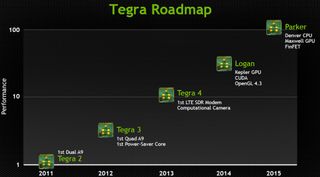Nvidia Newest Samsung Foundry Customer For 14nm Process, After Apple And Qualcomm

Although Samsung's smartphone unit has been taking a dive in terms of profits lately, and the jury is still out on how successful the next-generation Galaxy S6 will be, it seems Samsung will do quite well this year with its chip and foundry divisions.
According to Business Korea, Nvidia will dump TSMC's 16nm FinFET process and use Samsung's 14nm FinFET process instead. Nvidia has been hinting in its Tegra roadmap that it will use TSMC's 16nm FinFET process, and it's been a TSMC customer for a long time.
Only three quarters before its 16nm chips were supposed to come out, there's a report that Nvidia has switched to Samsung's 14nm process, and as a benefit, Nvidia will get to launch its next-generation process chips at least a quarter earlier.
Park Yu-ak, an analyst at Meritz Securities, said, "Global AP makers are likely to focus on lowering the cost of production this year in order to offset a decline in AP prices." He added, "Samsung's system semiconductor business is going to mass produce and supply chips to Apple, Qualcomm, and Nvidia starting in the second quarter of this year. As a result, the Korean tech giant is projected to exhibit stellar performance."
Faster time to market for a 14/16nm process seems to be the main reason why not just Nvidia, but also Apple and Qualcomm have gone with Samsung for their next-generation chips. Apple was already trying to reduce its reliance on Samsung's foundry, and as such, the company produced its A8 chip fully on TSMC's 20nm process.
The faster time to market for Samsung's 14nm process as well as potentially slightly bigger performance or power consumption benefits on TSMC's 16nm process must have convinced Apple that it's worth going back to Samsung.
The first chip that will be built on Samsung's 14nm will be the company's own Exynos 7, which will appear first inside the Galaxy S6. Samsung has fully taken advantage of some of the technical issues that Qualcomm's Snapdragon 810 has been having as incentive (legitimate or not) to completely switch the Galaxy S6 to its own chip. The company will give its own Exynos 7 a boost in performance and power consumption over the 20nm Snapdragon 810 by using the 14nm process, as well. The Galaxy S6 with the Exynos 7 chip is expected to arrive in March.
Stay on the Cutting Edge
Join the experts who read Tom's Hardware for the inside track on enthusiast PC tech news — and have for over 25 years. We'll send breaking news and in-depth reviews of CPUs, GPUs, AI, maker hardware and more straight to your inbox.
Nvidia has yet to unveil which of its chips will be built on 14nm, but from the previous roadmap, we can see that it will use the Maxwell GPU architecture and potentially the Denver CPU core. That is, unless Nvidia has completely given up on Denver, in which case the company will probably use Cortex A57 and Cortex A53, just like in the Tegra X1.
Follow us @tomshardware, on Facebook and on Google+.
-
Lmah Too bad it's probably for the mobile platform, I don't see 14nm desktop GPUs coming anytime soon. Hopefully they surprise us though. I'm actually surprised Samsung would work with Nvidia after the rocky last 2 years. I don't even think Nvidia put Samsung memory on any recent GPUs. I could be wrong though.Reply -
balister Reply15215783 said:Too bad it's probably for the mobile platform, I don't see 14nm desktop GPUs coming anytime soon. Hopefully they surprise us though. I'm actually surprised Samsung would work with Nvidia after the rocky last 2 years. I don't even think Nvidia put Samsung memory on any recent GPUs. I could be wrong though.
We will be seeing 14nm GPUs this year, this is why we didn't see the GTX 970 and 980 launch at 20nm because TSMC was going to skip the drop from 28nm to 20nm and go straight to 14nm to keep up with other foundaries. -
tslot05qsljgo9ed Nvidia's SOCs are on a yearly release. The X1 was just announced and the next announcements will be Jan 2016 at CES.Reply
If Nvidia is really going to use Samsung's 14nm FinFET process then it will be for next gen GPUs and a possible Denver SOC later in the year. -
Wisecracker Reply...That is, unless Nvidia has completely given up on Denver, in which case the company will probably use Cortex A57 and Cortex A53
I don't really give a poop one way or the other, but you should likely avoid such supposition without basis (new road map, report, press release, etc.).
-
bustapr Businesses like these always surprise me. They announced they will be working together all the while they sue the nuts off eachother. Or has the whole velocity micro incident been resolved?Reply -
sea monkey ReplyThe company will give its own Exynos 7 a boost in performance and power consumption over the 20nm Snapdragon 810
A boost in power consumption... yay? -
ferwindjacks Skip from 28nm to 14nm? I don't see it. I can see Nvidia milking 20nm and 16nm finFET, but going to 14 is a big leap. I guess I'm just used to the minor jumps now, used to jump 20 and more at a time.Reply -
Johan Kryger Haglert sea monkey: They likely mean in a positive direction, boost in power preservation? =PReply
Most Popular



